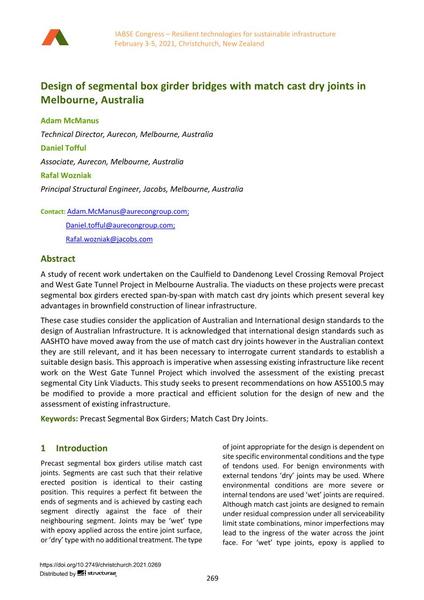Design of segmental box girder bridges with match cast dry joints in Melbourne, Australia

|
|
|||||||||||
Détails bibliographiques
| Auteur(s): |
Adam McManus
(Technical Director, Aurecon, Melbourne, Australia)
Daniel Tofful (Associate, Aurecon, Melbourne, Australia) Rafal Wozniak (Principal Structural Engineer, Jacobs, Melbourne, Australia) |
||||
|---|---|---|---|---|---|
| Médium: | papier de conférence | ||||
| Langue(s): | anglais | ||||
| Conférence: | IABSE Congress: Resilient technologies for sustainable infrastructure, Christchurch, New Zealand, 3-5 February 2021 | ||||
| Publié dans: | IABSE Congress Christchurch 2020 | ||||
|
|||||
| Page(s): | 269-275 | ||||
| Nombre total de pages (du PDF): | 7 | ||||
| DOI: | 10.2749/christchurch.2021.0269 | ||||
| Abstrait: |
A study of recent work undertaken on the Caulfield to Dandenong Level Crossing Removal Project and West Gate Tunnel Project in Melbourne Australia. The viaducts on these projects were precast segmental box girders erected span-by-span with match cast dry joints which present several key advantages in brownfield construction of linear infrastructure. These case studies consider the application of Australian and International design standards to the design of Australian Infrastructure. It is acknowledged that international design standards such as AASHTO have moved away from the use of match cast dry joints however in the Australian context they are still relevant, and it has been necessary to interrogate current standards to establish a suitable design basis. This approach is imperative when assessing existing infrastructure like recent work on the West Gate Tunnel Project which involved the assessment of the existing precast segmental City Link Viaducts. This study seeks to present recommendations on how AS5100.5 may be modified to provide a more practical and efficient solution for the design of new and the assessment of existing infrastructure. |
||||
